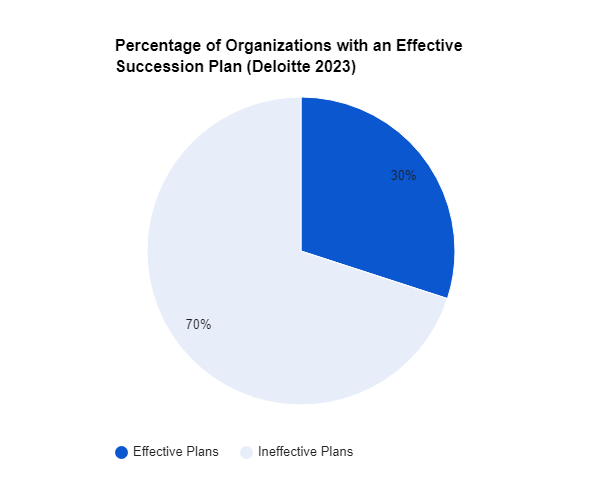Empowering Current Leaders for Seamless Succession: A Practical Guide

I vividly recall a discussion I had with an experienced CEO, who shared his concerns about the future leadership of his company. With many of his senior executives approaching retirement, he worried about the potential void in leadership.
This conversation highlighted the pervasive issue of succession planning, or the lack thereof, in many organizations. Despite its critical importance in ensuring organizational continuity and growth, succession planning is often overlooked or taken for granted.
Why Leadership succession planning Matters
In a 2023 Deloitte report, it was revealed that only 44% of organizations have a succession plan in place, and only 30% of those plans are considered to be effective.

Another study by PwC, conducted in 2022, found that 72% of organizations are concerned about their ability to develop and retain future leaders.
The 2021 Succession Planning Survey” by DDI found that 84% of organizations believe that succession planning is important, but only 56% of organizations have a formal succession plan in place. The report also found that organizations are struggling to measure the effectiveness of their succession planning efforts.

These statistics paint a sobering picture of the challenges faced by organizations in grooming the next generation of leaders.
The consequences of inadequate succession planning can be profound. Without a pipeline of qualified successors, organizations risk facing leadership vacuums, knowledge gaps, and a stifled capacity for innovation.
As a result, they may struggle to adapt to changing market conditions, capitalize on emerging opportunities, and maintain their competitive edge.
On the contrary, effective succession planning can be a catalyst for organizational resilience and growth. When done well, it ensures a seamless transition of power, preserves institutional knowledge, and fosters a culture of continuous learning and development.
Organizations with robust succession plans are better equipped to navigate the complexities of the business landscape and achieve long-term success.
I am convinced that succession planning is not just about filling in leadership roles; it’s about investing in the future of the organization. It’s about identifying and nurturing the talent that will not only sustain the organization but also propel it forward.
As a current or aspiring leader, you play a crucial role in shaping the future leadership of your organization. Your willingness to embrace succession planning, mentor emerging leaders, and facilitate their growth is essential for building a strong leadership pipeline.
As a leader, trainer, coach, and consultant with over 20 years of experience in the business world, I have witnessed the importance of succession planning in ensuring organizational resilience and growth.
Succession planning is the process of identifying and developing potential future leaders and senior managers, as well as individuals to fill other business-critical positions, either in the short- or the long-term.
We play a critical role in identifying, mentoring, coaching, and developing the next generation of leaders. We also need to create a culture of learning and feedback that fosters leadership development across the organization.
That is why I have created this guide as a practical resource for current leaders who want to empower themselves and their successors in succession planning.
In this guide, I will share with you the following:
- The benefits and challenges of succession planning
- A framework for assessing your current succession planning readiness and gaps
- A step-by-step process for creating and implementing a succession plan
- A set of tools and best practices for developing and supporting your successors
- A way to measure and evaluate the effectiveness of your succession plan
I am sure that by following this guide, you will be able to create a seamless transition of leadership and ensure the continuity and success of your organization. You will also be able to enhance your own leadership skills and legacy, as well as the skills and potential of your successors.
Identifying High-Potential Leaders
As a leader, I’ve always been fascinated by the ability to recognize and nurture individuals with the potential to transform into exceptional leaders.
It’s like having an eye for hidden gems, discovering those who possess the spark and drive to shape the future of an organization.
Identifying high-potential leaders is not just about filling vacancies; it’s about cultivating a talent pool that will fuel innovation, growth, and long-term success.
So, how do we spot these hidden gems?
It’s not an exact science, but there are certain traits and characteristics that tend to set high-potential leaders apart. They are often individuals who demonstrate a strong work ethic, a knack for problem-solving, and a willingness to step outside their comfort zones. They possess a contagious enthusiasm, inspiring others to pursue excellence.
Identifying high-potential leaders requires a keen eye for talent and a commitment to fostering their development. It’s about looking beyond current roles and responsibilities and recognizing the potential that lies within.
Key Traits and Characteristics of High-Potential Leaders
Different organizations may have different criteria and expectations for their future leaders, depending on their culture, goals, and challenges.
But, there are some common traits and characteristics that are often associated with high-potential leaders, such as:

Performance:
- High-potential leaders consistently deliver high-quality results and exceed expectations in their current roles.
- They demonstrate a strong work ethic, a commitment to excellence, and a willingness to learn and improve.
- Show initiative, creativity, and problem-solving skills in overcoming obstacles and achieving goals.
Potential:
- High-potential leaders have the capacity and the desire to grow and take on more complex and challenging roles and responsibilities in the future.
- They demonstrate a high level of self-awareness, self-regulation, and self-motivation.
- Also show curiosity, openness, and adaptability to new situations and opportunities.
Passion:
- High-potential leaders have a clear sense of purpose and direction for themselves and the organization.
- Demonstrate a high level of engagement, enthusiasm, and loyalty to the organization and its mission, vision, and values.
- They also show empathy, respect, and influence in building and maintaining positive relationships with others.
Principles:
- High-potential leaders have a strong sense of ethics and integrity.
- They demonstrate a high level of accountability, responsibility, and honesty in their actions and decisions.
- They also show courage, resilience, and humility in facing challenges and learning from mistakes.
Practical Strategies for Identifying High-Potential Leaders
Identifying high-potential leaders is an ongoing process that requires a systematic and objective approach.
Here are some practical strategies that you can use to identify high-potential leaders in your organization:
Performance Reviews:
Performance reviews are a regular and formal way of evaluating the performance and potential of your employees.
They provide you with an opportunity to review the achievements, strengths, weaknesses, and goals of your employees, as well as to give them feedback and recognition.
Organizations/Leaders can use performance reviews to identify high-potential leaders by looking for evidence of the key traits and characteristics mentioned above, as well as by asking questions such as:
- How have you contributed to the success of the organization in the past year?
- What are the most significant challenges that you have faced and overcome in your current role?
- What are the most valuable skills and competencies that you have developed or improved in your current role?
- What are your short-term and long-term career aspirations and goals?
- How do you align your personal and professional values with the values of the organization?
- How do you cope with change and uncertainty in the work environment?
- How do you collaborate and communicate with others in the organization?
- How do you handle feedback and criticism?
- How do you learn from your successes and failures?
360-Degree Assessments:
360-degree assessments are a comprehensive and multi-dimensional way of evaluating the performance and potential of your employees.
It involve collecting feedback from multiple sources, such as peers, subordinates, superiors, customers, and other stakeholders, who have direct or indirect interactions with your employees.
Decision makers can use 360-degree assessments to identify high-potential leaders by looking for patterns and themes in the feedback, you can blend some questions in personal interactions, such as:
- How others perceive your performance and potential in your current role?
- How your colleagues describe your strengths and areas of improvement in your current role?
- How will your superiors and subordinates rate your skills and competencies considering your current role?
- How do others appreciate your contribution and impact in the organization?
- How do others value your engagement and commitment to the organization and its mission, vision, and values?
- How do others respect your ethics and integrity in your actions and decisions?
- How do others trust your influence and leadership in the organization?
Leadership Development Programs:
Leadership development programs are a structured and intentional way of developing the performance and potential of your employees.
These programs involve providing your employees with learning and development opportunities, such as training, coaching, mentoring, shadowing, and project assignments, that are designed to enhance their skills and competencies, as well as to expose them to new and challenging situations and roles.
You can use leadership development programs to identify high-potential leaders by looking for indicators of the key traits and characteristics mentioned above, as well as by asking questions such as:
- How can you apply the knowledge and skills that you have learned in the leadership development program to your current role and responsibilities?
- How do you demonstrate your initiative and creativity in the leadership development program and in your current role and responsibilities?
- What are the steps to cope with the complexity and ambiguity in the leadership development program and in your current role and responsibilities?
- How do you show your curiosity and openness to new and different perspectives and experiences in the leadership development program and in your current role and responsibilities?
- In which possible ways you can demonstrate your engagement and enthusiasm in the leadership development program and in your current role and responsibilities?
- How do you demonstrate your empathy and respect in the leadership development program and in your current role and responsibilities?
- Can you demonstrate your accountability and responsibility in the leadership development program and in your current role and responsibilities?
- How do you demonstrate your courage and resilience in the leadership development program and in your current role and responsibilities?
Facilitating Knowledge Transfer
Another important step in succession planning is to facilitate knowledge transfer between current leaders and potential successors.
Knowledge transfer is the process of sharing and transferring the institutional knowledge and expertise that current leaders have accumulated over the years, to potential successors who will need them to perform their future roles and responsibilities.
Knowledge transfer is significant for preserving the organizational memory and culture, as well as for ensuring the continuity and quality of the organizational processes and outcomes.
It is also significant for enhancing the confidence and competence of potential successors, as well as for reducing the learning curve and the risk of errors and mistakes.
Steps for facilitating knowledge transfer between current leaders and potential successors:
Identify the critical knowledge and expertise
The first step is to identify the critical knowledge and expertise that current leaders possess and that potential successors will need. This includes both explicit and tacit knowledge.
Explicit knowledge is the knowledge that can be easily articulated, documented, and transmitted, such as facts, rules, procedures, and policies.
Tacit knowledge is the knowledge that is difficult to articulate, document, and transmit, such as skills, experiences, insights, and intuitions.
You can use various methods and tools, such as interviews, surveys, audits, and inventories, to identify the critical knowledge and expertise of current leaders.
Prioritize the knowledge and expertise
The next step is to prioritize the knowledge and expertise that current leaders possess and that potential successors will need.
This involves assessing the importance and the urgency of the knowledge and expertise, as well as the availability and the accessibility of the knowledge and expertise.
You can use various criteria and metrics, such as impact, frequency, complexity, and uniqueness, to prioritize the knowledge and expertise of current leaders.
Select the knowledge transfer methods
The third step is to select the appropriate knowledge transfer methods for sharing and transferring the knowledge and expertise of current leaders to potential successors.
Its involves choosing the methods that are suitable for the type, the level, and the context of the knowledge and expertise, as well as for the preferences and the needs of the current leaders and potential successors.
We can use various formal and informal methods, such as documentation, mentorship sessions, and collaborative projects, to facilitate knowledge transfer between current leaders and potential successors.
Implement the knowledge transfer methods
The fourth step is to implement the selected knowledge transfer methods for sharing and transferring the knowledge and expertise of current leaders to potential successors.
This involves planning, executing, and monitoring the knowledge transfer activities, as well as providing the necessary resources and support for the current leaders and potential successors.
Best to use various techniques and tools, such as schedules, checklists, and feedback mechanisms, to implement the knowledge transfer methods between current leaders and potential successors.
Evaluate the knowledge transfer outcomes
The final step is to evaluate the outcomes and the effectiveness of the knowledge transfer process between current leaders and potential successors.
The process involves measuring and assessing the results and the impacts of the knowledge transfer activities, as well as identifying the strengths and the areas of improvement of the knowledge transfer process.
Try to use various indicators and methods, such as tests, surveys, and interviews, to evaluate the knowledge transfer outcomes between current leaders and potential successors.
Navigating Resistance and Challenges
Preparing current leaders for succession is not an easy or smooth process. It can encounter various challenges and obstacles, both from the current leaders themselves and from the organization as a whole. Some of the potential challenges are:
Power dynamics
Current leaders may feel threatened or insecure by the presence and the development of potential successors, who may challenge their authority, status, and influence in the organization.
They normally feel reluctant or resistant to share their knowledge and expertise, which may give them a sense of power and control over the organization and its processes.
Ego
Current leaders may have a strong sense of identity and pride associated with their current roles and responsibilities, which may make them unwilling or unable to let go of them and to embrace new and different roles and responsibilities.
They may also have a high level of confidence and self-esteem, which may make them overestimate their abilities and underestimate their successors’ abilities.
Fear of replacement
Current leaders may fear that they will become obsolete or irrelevant once they hand over their roles and responsibilities to their successors.
There is a fear that they will lose their purpose and meaning in the organization and in their careers. It is normal to fear that they will not be able to find or create new and fulfilling opportunities for themselves after their succession.
These challenges can hinder the succession planning process and create a negative and hostile culture for succession planning.
So, it is important to address these challenges and to build a supportive and positive culture for succession planning. Here are some strategies for doing so:
Communicate the vision and the value of succession planning:
The first strategy is to communicate the vision and the value of succession planning to the current leaders and to the organization as a whole.
Explaining the benefits and the outcomes of succession planning, such as ensuring organizational resilience and growth, enhancing leadership skills and legacy, and creating new and exciting opportunities for current and future leaders.
It also involves addressing the myths and the misconceptions about succession planning, such as that it is a sign of weakness, disloyalty, or failure, or that it is a threat, a competition, or a replacement.
Involve the current leaders in the succession planning process:
The second strategy is to involve the current leaders in the succession planning process, and to make them feel valued and appreciated.
Soliciting their input and feedback, and incorporating their ideas and suggestions, in the succession planning process, such as identifying, developing, and supporting potential successors, and facilitating knowledge transfer.
You must consider recognizing and rewarding their contributions and achievements, and celebrating their successes and accomplishments, in the succession planning process, such as mentoring, coaching, and developing potential successors, and sharing and transferring knowledge and expertise.
It has been seen that by involving the current leaders in the succession planning process, you can make them feel empowered and engaged, as well as respected and appreciated, in the succession planning process.
Provide the current leaders with new and different roles and responsibilities
The third strategy is to provide the current leaders with new and different roles and responsibilities, and to make them feel challenged and fulfilled.
Creating and offering new and different roles and responsibilities for the current leaders, such as advisory, strategic, or project-based roles, that can leverage their skills and competencies, as well as their knowledge and expertise, and that can provide them with new and different perspectives and experiences.
It also involves providing them with the necessary resources and support, such as training, coaching, and mentoring, to help them transition and adapt to their new and different roles and responsibilities.
You will notice that by providing the current leaders with new and different roles and responsibilities, you are making them feel challenged and fulfilled, as well as motivated and inspired, in their new and different roles and responsibilities.
Measuring Success and Continuously Improving
It is essential to measure the success and the effectiveness of your succession planning initiatives, and to continuously improve and adapt your succession planning strategies to meet the evolving needs and challenges of your organization.
There are various methods and tools that you can use to evaluate the effectiveness of your succession planning initiatives, such as:
Surveys
Surveys are a quantitative and qualitative way of collecting data and feedback from your current and potential successors, as well as from other stakeholders, such as peers, subordinates, superiors, customers, and partners, who are involved or affected by your succession planning process.
Surveys can measure various aspects of your succession planning process, such as the satisfaction, engagement, motivation, and retention of your current and potential successors, as well as the impact, quality, and efficiency of your succession planning outcomes.
Interviews
You can use interviews to explore various aspects of your succession planning process, such as the experiences, perceptions, opinions, and suggestions of your current and potential successors, as well as the challenges, opportunities, and best practices of your succession planning process.
Tests
Tests are a quantitative and objective way of measuring the knowledge, skills, and competencies of your potential successors, as well as their performance and potential in their current and future roles and responsibilities.
There are various types of tests, such as cognitive, behavioral, situational, and simulation tests, to assess various aspects of your potential successors, such as their strategic thinking, decision making, communication, collaboration, innovation, change management, and emotional intelligence.
Tracking the Progress and Development of Potential Successors
Tracking the progress and development of your potential successors is vital for ensuring that your potential successors are ready and prepared for their future roles and responsibilities, and that they are achieving their personal and professional goals and objectives.
It is also important for providing feedback and recognition to your potential successors, and for adjusting and modifying your succession planning strategies and activities accordingly.
There are various metrics that you can use to track the progress and development of your potential successors, such as:
Performance indicators:
Performance indicators are the measures of the results and the outcomes of your potential successors in their current and future roles and responsibilities, such as the quality, quantity, timeliness, and efficiency of their work outputs and outcomes, as well as the impact, value, and benefit of their work outputs and outcomes for the organization and its stakeholders.
Potential indicators:
Potential indicators are the measures of the capacity and the aspiration of your potential successors to grow and take on more complex and challenging roles and responsibilities in the future, such as the level of self-awareness, self-regulation, and self-motivation of your potential successors, as well as the level of curiosity, openness, and adaptability of your potential successors to new situations and opportunities.
Passion indicators:
Passion indicators are the measures of the engagement and the enthusiasm of your potential successors in their current and future roles and responsibilities, as well as in the organization and its mission, vision, and values, such as the level of commitment, loyalty, and loyalty of your potential successors to the organization and its mission, vision, and values, as well as the level of empathy, respect, and influence of your potential successors in building and maintaining positive relationships with others.
Principle indicators:
Principle indicators are the measures of the ethics and the integrity of your potential successors in their current and future roles and responsibilities, as well as in the organization and its culture, such as the level of accountability, responsibility, and honesty of your potential successors in their actions and decisions, as well as the level of courage, resilience, and humility of your potential successors in facing challenges and learning from mistakes.

Continuously Improving and Adapting Succession Planning Strategies
Continuously improving and adapting your succession planning strategies is essential for ensuring that your succession planning process is responsive and relevant to the changing needs and challenges of your organization and its environment.
It is also essential for ensuring that your succession planning process is innovative and creative, and that it provides new and exciting opportunities for your current and potential successors.
There are various ways that you can continuously improve and adapt your succession planning strategies, such as:
Reviewing and revising:
Objectives and outcomes:
You can align them with your organizational goals and values, as well as with the external trends and opportunities, such as the market, the industry, the technology, and the society.
Criteria and expectations:
You must ensure that they are realistic and achievable, as well as that they reflect the skills and competencies, as well as the knowledge and expertise, that your current and potential successors will need in their current and future roles and responsibilities.
Methods and tools:
Make sure that they are suitable and effective, as well as that they provide the necessary resources and support, for identifying, developing, and supporting your potential successors, and for facilitating knowledge transfer between current leaders and potential successors.
Metrics and indicators:
You can review and revise your succession planning metrics and indicators, and ensure that they are relevant and reliable, as well as that they provide the necessary data and feedback, for measuring the success and the effectiveness of your succession planning initiatives, and for tracking the progress and development of your potential successors.
Before I conclude, I would like to provide few real-life examples of succession planning:
Succession planning benefits:
One of the most successful examples of succession planning is the case of Apple, the technology giant.
Apple has a well-established and rigorous succession planning process, which involves identifying, developing, and supporting high-potential leaders, as well as facilitating knowledge transfer between current and future leaders.
Apple’s succession planning process has enabled the company to maintain its innovation and growth, as well as to overcome the challenges and uncertainties in the market and the industry.
One of the most notable outcomes of Apple’s succession planning process is the smooth and seamless transition of leadership from Steve Jobs to Tim Cook, who has continued to lead the company to new heights of success and excellence .
Succession planning challenges:
The case of GE, the industrial conglomerate. GE has a long history and reputation of having a robust and effective succession planning process, which involves grooming and preparing potential successors for various leadership roles and positions.
However, GE’s succession planning process has faced various challenges and obstacles in recent years, such as the lack of alignment between the succession planning objectives and the organizational goals and values, the lack of involvement and engagement of the current and potential leaders in the succession planning process, and the lack of adaptation and improvement of the succession planning strategies and methods.
These challenges have resulted in the poor performance and potential of the potential successors, as well as the disruption and instability of the leadership transition and continuity .
Succession planning strategies:
Best example of succession planning strategies is the case of IBM, the technology and consulting company.
IBM has a comprehensive and innovative succession planning process, which involves using various methods and tools to identify, develop, and support potential successors, as well as to facilitate knowledge transfer between current and future leaders.
Some of the methods and tools that IBM uses are:
Performance reviews: IBM uses a performance management system called Checkpoint, which allows the current and potential leaders to set and review their goals and objectives, as well as to receive and provide feedback and recognition, on a regular and frequent basis.
360-degree assessments: IBM uses a 360-degree feedback system called Personal Business Commitments, which allows the current and potential leaders to receive and provide feedback from and to multiple sources, such as peers, subordinates, superiors, customers, and partners, on various aspects of their performance and potential, such as their skills, competencies, behaviors, and values.
Leadership development programs: IBM offers various leadership development programs, such as the Basic Blue for Managers, the Global Leadership Development Program, and the Executive Leadership Development Program, which provide the current and potential leaders with various learning and development opportunities, such as training, coaching, mentoring, shadowing, and project assignments, to enhance their skills and competencies, as well as to expose them to new and challenging situations and roles.
Knowledge transfer methods: IBM uses various knowledge transfer methods, such as documentation, mentorship sessions, and collaborative projects, to share and transfer the knowledge and expertise of the current leaders to the potential successors. One of the most notable knowledge transfer methods that IBM uses is the Corporate Service Corps, which is a program that sends the current and potential leaders to work on social and environmental projects in various countries, where they can learn from and share their knowledge and expertise with the local communities and organizations.
Final Thoughts
In this guide, I have discussed the critical role of current leaders in ensuring a smooth and successful succession process. Current leaders play a vital role in identifying, developing, and supporting potential successors, as well as in facilitating knowledge transfer between current and future leaders.
I have also encouraged current leaders to embrace their responsibility in preparing successors, and to view succession planning as an opportunity and a privilege, rather than as a threat or a burden. Succession planning is not only beneficial for the organization, but also for the individual leaders, as it can enhance their motivation, engagement, and retention, as well as their leadership skills and legacy.
I also tried to emphasize the long-term benefits of effective succession planning for organizational sustainability and growth. It can also help the organization to maintain its innovation and competitiveness, as well as to attract and retain talent and customers.
I hope you have found this guide useful and informative, and that you will apply the concepts and strategies that I have shared with you in your own succession planning process.
I wish you all the best in your succession planning journey, and I thank you for your time and attention.
“Succession Planning: A Review of the Literature” by Michael Useem and Deborah Fraser
Developing Leaders for Succession: A Practical Guide” by Ram Charan
“The Global Leadership Forecast 2020” by DDI





